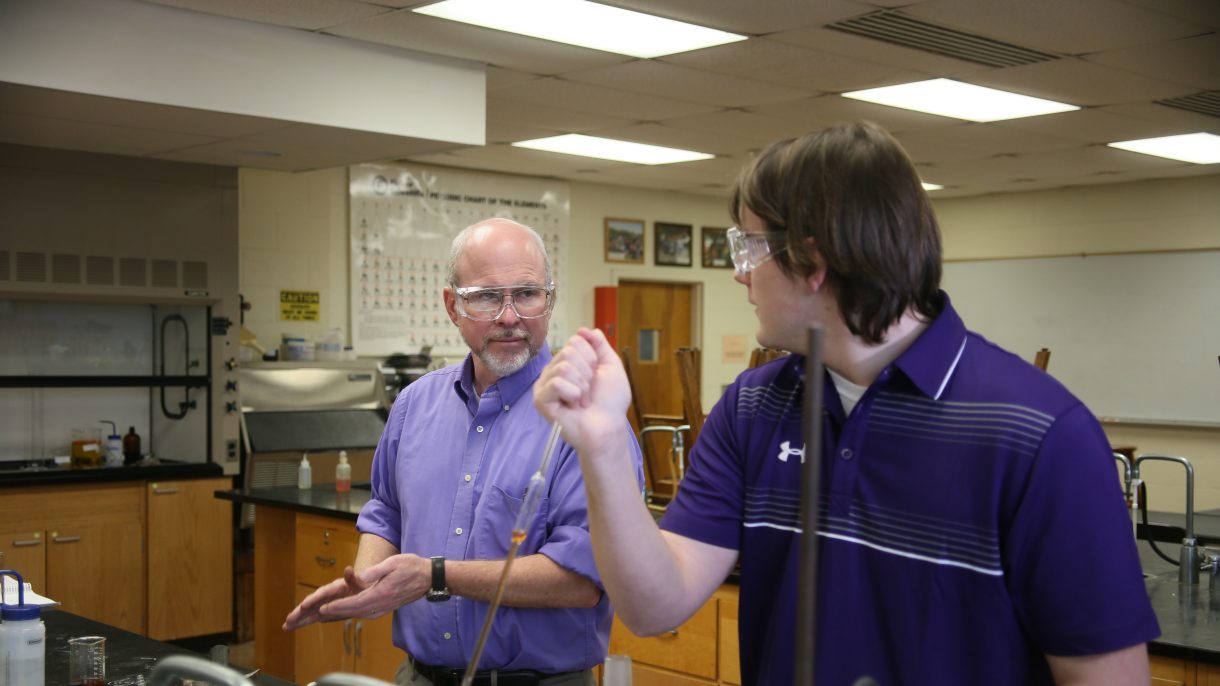
Meet Our Faculty: Dr. Bruce Branan
Originally published in Winter 2018
On the hard surface of a lab table, Dr. Bruce Branan cracked a black walnut with a claw hammer. The tough hull splintered and spun across the table.
“Very scientific,” he said, grinning, as he collected the fragments of hull and removed the nut meat.
Jokes aside, Branan was engaged in serious research, testing locally harvested walnuts for the presence of Ochratoxin A, a fungal toxin occurring in many foods. Building on existing research, the continuing project is not only a contribution to the scientific discussion — it’s also an outstanding opportunity for Biology major Bryce Forry ’20, who is working closely with Branan on the project.
Forry, who plans to attend medical school, is just one of the many students Branan has mentored throughout his time at Asbury. The Ochratoxin A project illustrates Branan’s dedication to student research at Asbury. He enjoys the sense of discovery research provides — and even more, he enjoys sharing it.
“There is an appeal to finding something that no one has seen before,” Branan said. “Being able to do this with students is a bonus. They learn some area that isn’t part of the usual curriculum (or is an extension of it), they learn new instruments and techniques, and together we both try to find answers to the problem at hand.”
For student research to be effective, Branan says, it needs to focus on real issues, scaled to proportions that undergraduate students can integrate in their full schedules. This dynamic requires creativity on the part of professors — a challenge Branan seems to relish.
“Graduate projects in science benefit from having grad students work full time for two to four years in the lab,” Branan said. “They are able to work six to 10 hours a week. That difference means we have to think carefully about our plans so we can be efficient with our time in the lab. When I learn about something new and interesting I frequently ask myself, ‘What can we do with this at Asbury?’ ‘What is a new question we can investigate,’ or ‘How would doing it this different way make a difference?’”
Branan’s passion for sharing research has led to a rich variety of experiences and challenges. His projects with students have included research on pharmaceuticals in treated wastewater (Allegra Forwith ’16, Rebecca Bolinger ’17, Hunter Mitchell ’18 and Caleb Hartley ’21); building an ozone generator (Josh Butcher ’05); the effect of growth elevation on chemicals in tea (Kenton Sena ’12) and many, many more.
“I want students to take ownership of their project, and I soon step back and allow them to come to me with their findings,” Branan said. “This develops independence and hopefully the ability to begin finding answers and solving problems themselves before asking for my help. Tyler Ogden ’16, in our research comparing tea steeping methods on the chemicals in tea, was the best example I’ve seen of this. He became the expert on our HPLC instrument, and helped train his peers when they learned that instrument in CHE 322, Chemical Instrumentation.”
It’s not only students who benefit from Branan’s projects — his constant quest for discovery, grounded in a teaching framework at Asbury, sparks personal and professional growth, as well.
“Research at Asbury has afforded me a chance to try on new hats,” Branan said. “I was trained as a synthetic organic chemist. If I were a full-time researcher, I’d be doing that. But here, we’ve gotten much more into analytical chemistry, studying teas, learning new instruments and methods, and now getting into environmental chemistry with antidepressants in water, food chemistry, toxins in black walnuts. I feel like I’ve grown professionally in ways I never imagined when you come out of graduate school and start teaching.”
Branan’s prioritization of student research has impacted campus well beyond the sciences. The science poster presentations he began seven years ago directly inspired the SEARCH Symposium, an interdisciplinary celebration of student research.
“I wanted to highlight in the spring the research projects our seniors were doing in their required senior research projects,” Branan said. “Some of the students were working all summer at large research institutions on NIH or NSF funded projects. These were top-notch, very sophisticated investigations, and the students had contributed greatly to the progress of the research and had a solid grasp of the intricacies of the work. I felt strongly that they should have the opportunity to display this to their peers in science, the faculty, and the general Asbury community.”
Now, through SEARCH, students from all disciplines can share their work, giving the Asbury community an opportunity to celebrate the excellent research being done across campus.
“This is what SEARCH is about — celebrating what students have learned and achieved through hard work and study,” Branan said. “It gives participants (the students) the opportunity to enjoy the fruits of their labors (which in academia is usually the sharing/publishing of what one has learned), and plant seeds of inspiration in the underclassmen of what they can do.”